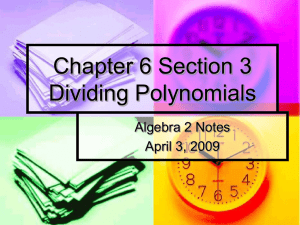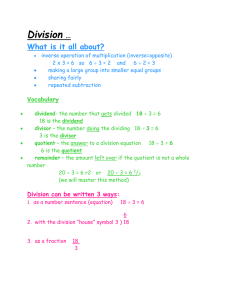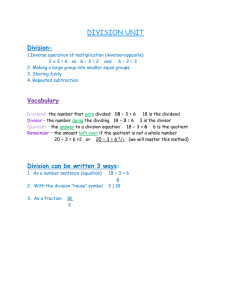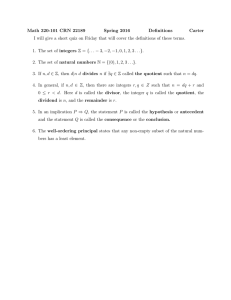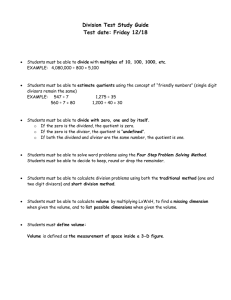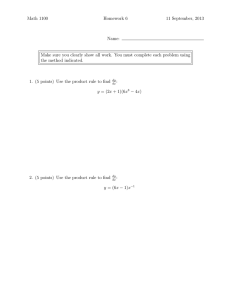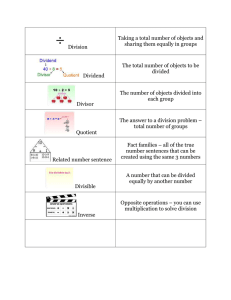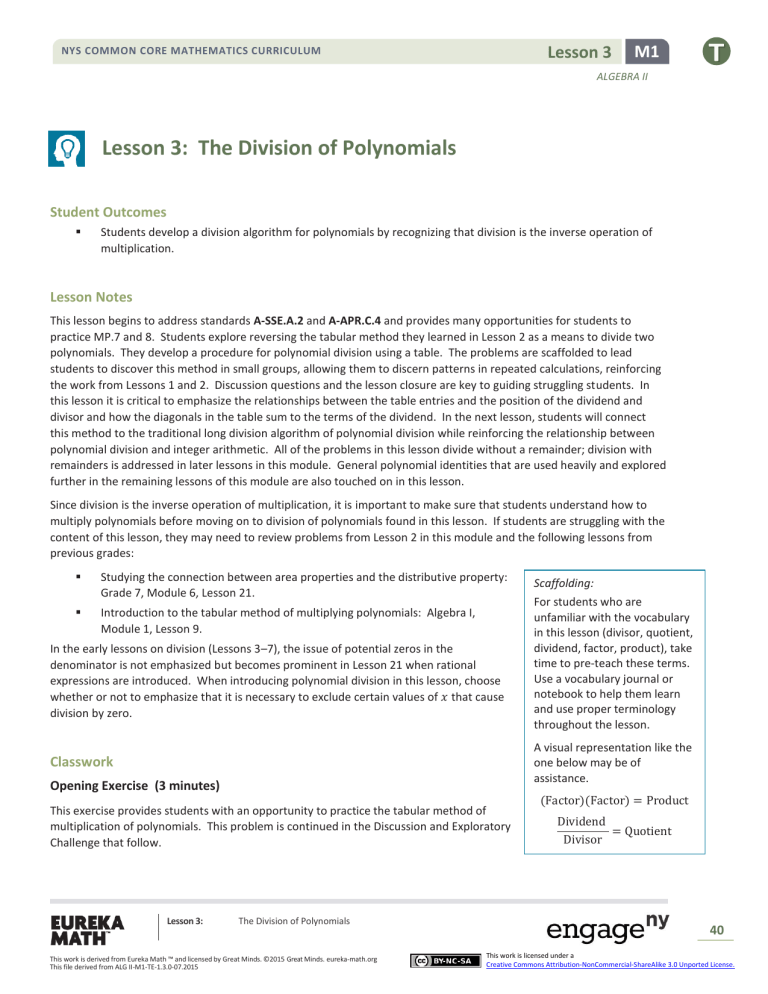
Lesson 3 NYS COMMON CORE MATHEMATICS CURRICULUM M1 ALGEBRA II Lesson 3: The Division of Polynomials Student Outcomes Students develop a division algorithm for polynomials by recognizing that division is the inverse operation of multiplication. Lesson Notes This lesson begins to address standards A-SSE.A.2 and A-APR.C.4 and provides many opportunities for students to practice MP.7 and 8. Students explore reversing the tabular method they learned in Lesson 2 as a means to divide two polynomials. They develop a procedure for polynomial division using a table. The problems are scaffolded to lead students to discover this method in small groups, allowing them to discern patterns in repeated calculations, reinforcing the work from Lessons 1 and 2. Discussion questions and the lesson closure are key to guiding struggling students. In this lesson it is critical to emphasize the relationships between the table entries and the position of the dividend and divisor and how the diagonals in the table sum to the terms of the dividend. In the next lesson, students will connect this method to the traditional long division algorithm of polynomial division while reinforcing the relationship between polynomial division and integer arithmetic. All of the problems in this lesson divide without a remainder; division with remainders is addressed in later lessons in this module. General polynomial identities that are used heavily and explored further in the remaining lessons of this module are also touched on in this lesson. Since division is the inverse operation of multiplication, it is important to make sure that students understand how to multiply polynomials before moving on to division of polynomials found in this lesson. If students are struggling with the content of this lesson, they may need to review problems from Lesson 2 in this module and the following lessons from previous grades: Studying the connection between area properties and the distributive property: Grade 7, Module 6, Lesson 21. Introduction to the tabular method of multiplying polynomials: Algebra I, Module 1, Lesson 9. In the early lessons on division (Lessons 3–7), the issue of potential zeros in the denominator is not emphasized but becomes prominent in Lesson 21 when rational expressions are introduced. When introducing polynomial division in this lesson, choose whether or not to emphasize that it is necessary to exclude certain values of 𝑥 that cause division by zero. For students who are unfamiliar with the vocabulary in this lesson (divisor, quotient, dividend, factor, product), take time to pre-teach these terms. Use a vocabulary journal or notebook to help them learn and use proper terminology throughout the lesson. A visual representation like the one below may be of assistance. Classwork Opening Exercise (3 minutes) This exercise provides students with an opportunity to practice the tabular method of multiplication of polynomials. This problem is continued in the Discussion and Exploratory Challenge that follow. Lesson 3: Scaffolding: The Division of Polynomials This work is derived from Eureka Math ™ and licensed by Great Minds. ©2015 Great Minds. eureka-math.org This file derived from ALG II-M1-TE-1.3.0-07.2015 (Factor)(Factor) = Product Dividend = Quotient Divisor 40 This work is licensed under a Creative Commons Attribution-NonCommercial-ShareAlike 3.0 Unported License. Lesson 3 NYS COMMON CORE MATHEMATICS CURRICULUM M1 ALGEBRA II Opening Exercise a. Multiply these polynomials using the tabular method. (𝟐𝒙 + 𝟓)(𝒙𝟐 + 𝟓𝒙 + 𝟏) The product is 𝟐𝒙𝟑 + 𝟏𝟓𝒙𝟐 + 𝟐𝟕𝒙 + 𝟓. b. How can you use the expression in part (a) to quickly multiply 𝟐𝟓 ⋅ 𝟏𝟓𝟏? If you let 𝒙 = 𝟏𝟎, then the product is 𝟐(𝟏𝟎)𝟑 + 𝟏𝟓(𝟏𝟎)𝟐 + 𝟐𝟕(𝟏𝟎) + 𝟓 = 𝟐𝟎𝟎𝟎 + 𝟏𝟓𝟎𝟎 + 𝟐𝟕𝟎 + 𝟓 = 𝟑𝟕𝟕𝟓. Discussion (5 minutes) Lead a discussion that connects multiplication and division. Display the following problem on the board, and ask how it could be transformed into a division problem. 25 ⋅ 151 = 3,775 How can a multiplication problem be rewritten as a division problem? One of the factors is the divisor and the other is the quotient. The product is the dividend. 3775 = 151 25 OR 3775 = 25 151 How can we rewrite the Opening Exercise as a division problem? (2𝑥 + 5)(𝑥 2 + 5𝑥 + 1) = 2𝑥 3 + 15𝑥 2 + 27𝑥 + 5 It would be rewritten the same way. One of the factors is the divisor and the other is the quotient. The product is the dividend. 2𝑥 3 + 15𝑥 2 + 27𝑥 + 5 = 𝑥 2 + 5𝑥 + 1 2𝑥 + 5 OR 2𝑥 3 + 15𝑥 2 + 27𝑥 + 5 = 2𝑥 + 5 𝑥 2 + 5𝑥 + 1 Let 𝑥 = 10. Substitute that value into each polynomial, and compare the results of multiplying and dividing the polynomials with the arithmetic problem. How do polynomial multiplication and division compare to multiplication and division of integers? When 𝑥 = 10, the polynomial problems result in the same values as the number problems. This reinforces the fact that arithmetic operations with polynomials are similar to arithmetic operations with integers. Exploratory Challenge (27 minutes): Reverse the Tabular Method to Divide Polynomials Give students time to discuss how they would fill in the rows and columns in the table below. Let them struggle to make sense of the problem and look for patterns. If they are proficient with the tabular method of multiplication, they should quickly discover a method for populating the table and then verifying that the quotient is in the top row. Read through this entire section before attempting this with students in order to clearly understand how the process works. Start this challenge by asking students to consider how they might reverse the tabular method for multiplying to solve a polynomial division problem. Lesson 3: The Division of Polynomials This work is derived from Eureka Math ™ and licensed by Great Minds. ©2015 Great Minds. eureka-math.org This file derived from ALG II-M1-TE-1.3.0-07.2015 41 This work is licensed under a Creative Commons Attribution-NonCommercial-ShareAlike 3.0 Unported License. Lesson 3 NYS COMMON CORE MATHEMATICS CURRICULUM M1 ALGEBRA II Encourage them to discuss where to position the polynomials now that they have the “answer” (the product) and one of the factors. In the last lessons on multiplication, the factors positioned along the top and right side of the table and the product positioned along the left and bottom came from summing the like terms in each diagonal. The student pages pose the problem and provide an empty two-row by three-column table. If needed, use the scaffolded tables provided in the teacher notes that follow to provide more support for students. Exploratory Challenge 1. Does 𝟐𝒙𝟑 +𝟏𝟓𝒙𝟐 +𝟐𝟕𝒙+𝟓 𝟐𝒙+𝟓 = (𝒙𝟐 + 𝟓𝒙 + 𝟏)? Justify your answer. The partially completed tables shown below provide some suggestions for scaffolding this lesson exploration (if needed). Encourage students to place the dividend where the product would result from multiplying and the quotient where one of the factors would be located. Then, have them work backward to show that the top row of this table is the quotient, 𝑥 2 + 5𝑥 + 1. Since the table is two by three, it would make sense that 2𝑥 + 5 is positioned along the vertical side on the right. Notice that the terms of the quotient are located around the left and bottom side of the table. This is where they would appear if these terms represented the result of multiplying two polynomials whose product was 2𝑥 3 + 15𝑥 2 + 27𝑥 + 5. Notice also that the divisor is positioned along the right side of the table (as was found with one of the factors in the earlier tabular method multiplication problems). The arrows in the diagram indicate that the diagonal entries must sum to the term outside the table (e.g., 15𝑥 2 = 5𝑥 2 + 10𝑥 2 ). 𝒙𝟐 + 𝟓𝒙 +𝟏 𝟐𝒙𝟑 𝟏𝟎𝒙𝟐 𝟐𝒙 𝟐𝒙 𝟐𝒙𝟑 𝟓𝒙𝟐 𝟐𝟓𝒙 𝟓 +𝟓 𝟏𝟓𝒙𝟐 𝟐𝟕𝒙 𝟓 𝟐𝒙 𝟐𝒙𝟑 𝟏𝟓𝒙𝟐 +𝟓 𝟐𝟕𝒙 Lesson 3: 𝟓 The Division of Polynomials This work is derived from Eureka Math ™ and licensed by Great Minds. ©2015 Great Minds. eureka-math.org This file derived from ALG II-M1-TE-1.3.0-07.2015 42 This work is licensed under a Creative Commons Attribution-NonCommercial-ShareAlike 3.0 Unported License. Lesson 3 NYS COMMON CORE MATHEMATICS CURRICULUM M1 ALGEBRA II After students have had a few minutes to discuss their ideas in groups, lead a short discussion (as needed) if they appear to be stuck. Use these questions to prompt groups while also circulating around the room. The quotient will be the polynomial that would go along the top of the table. Remember we know it should be 𝑥 2 + 5𝑥 + 1. How can you get started to confirm this using the dividend and the divisor? Are there any cells in the table that we can fill in based on the information we have? What must be in the top left cell? Why? It would have to be 𝑥 2 since that term and 2𝑥 must multiply to be 2𝑥 3. What goes in the rest of the cells in the first column? How can you continue this pattern? The 2𝑥 3 term will be the top left entry, and the 5 will be the bottom right entry. Because the diagonals add to produce the terms of the product, we know that the top left and bottom right entries must be the first and last terms of the dividend since those terms do not involve combining any like terms when we compute the product. What must the first term of the missing polynomial in the top row be? We need to think about how the divisor terms fill back into the table, and then we need to use the 2𝑥 and the 5 terms to determine the other factor for each column at the top of the table. Multiply 𝑥 2 and 5 to get 5𝑥 2 . Then the 2 column in the first row would need to be 10𝑥 2 because nd 15𝑥 2 = 10𝑥 2 + 5𝑥 2 . Since the 2 column of the first row is now known, we can figure out the remaining term of the quotient since that term times 2𝑥 would have to equal 10𝑥 2 . nd Compare your work on this problem with the Opening Exercise. How could you verify that 𝑥 2 + 5𝑥 + 1 really is the quotient? Explain? 2. In the Opening Exercise, we multiplied the quotient and divisor and got the dividend. So (2𝑥 + 5)(𝑥 2 + 5𝑥 + 1) must equal 2𝑥 3 + 15𝑥 2 + 27𝑥 + 5. Describe the process you used to determine your answer to Exercise 1. Student descriptions will vary but should be similar to the detailed directions provided on the following page. Check each group’s work before moving on to the next exercise. Have a couple of groups present their solution methods to the Exercises 1 and 2 on the board, especially if other groups seem to be struggling. Then, if needed, go over the steps outlined below in detail to clarify this process for all students. Provide additional scaffolding if needed. Step 1—Draw a table with factors along the right sides and bottom corner, and fill in known entries along the top left and bottom right. Lesson 3: The Division of Polynomials This work is derived from Eureka Math ™ and licensed by Great Minds. ©2015 Great Minds. eureka-math.org This file derived from ALG II-M1-TE-1.3.0-07.2015 43 This work is licensed under a Creative Commons Attribution-NonCommercial-ShareAlike 3.0 Unported License. Lesson 3 NYS COMMON CORE MATHEMATICS CURRICULUM M1 ALGEBRA II Step 2—Use the top left entry to find the second-degree term along the top. It has to be 𝑥 2 because 2𝑥 ∙ 𝑥 2 = 2𝑥 3 . Step 3—Use 𝑥 2 and 5 to find the bottom left entry, 5𝑥 2, and then use that entry to find the top middle term. It has to be 10𝑥 2 because 5𝑥 2 + 10𝑥 2 = 15𝑥 2 . nd Step 4—Repeat these steps to fill in the bottom entry in the 2 and last columns. Lesson 3: The Division of Polynomials This work is derived from Eureka Math ™ and licensed by Great Minds. ©2015 Great Minds. eureka-math.org This file derived from ALG II-M1-TE-1.3.0-07.2015 44 This work is licensed under a Creative Commons Attribution-NonCommercial-ShareAlike 3.0 Unported License. Lesson 3 NYS COMMON CORE MATHEMATICS CURRICULUM M1 ALGEBRA II Students do not already know the quotient in Exercise 3, making this more challenging than the previous exercises. 3. Reverse the tabular method of multiplication to find the quotient: 𝟐𝒙𝟐 +𝒙−𝟏𝟎 𝒙−𝟐 𝟐𝒙 +𝟓 𝟐𝒙𝟐 𝟓𝒙 𝒙 𝟐𝒙𝟐 −𝟒𝒙 −𝟏𝟎 −𝟐 𝒙 −𝟏𝟎 𝒙 𝟐𝒙𝟐 𝒙 −𝟐 −𝟏𝟎 After these two exercises, lead a short discussion to help students learn how to reverse their thinking about the tabular method of multiplication to divide polynomials. We will call this approach to dividing polynomials the reverse tabular method. Let’s make a conjecture about the number of rows and columns you will need to perform the division. How can you predict how many rows you will need in your table? How can you predict how many columns you will need in your table? 4. The number of rows will be one more than the degree of the divisor. The number of columns will be one more than the difference between the degree of the dividend and the degree of the divisor. Test your conjectures. Create your own table, and use the reverse tabular method to find the quotient. 𝒙𝟒 + 𝟒𝒙𝟑 + 𝟑𝒙𝟐 + 𝟒𝒙 + 𝟐 𝒙𝟐 + 𝟏 𝒙𝟐 +𝟒𝒙 +𝟐 𝒙𝟒 𝟒𝒙𝟑 𝟐𝒙𝟐 𝒙𝟐 𝒙𝟒 𝟎𝒙𝟑 𝟎𝒙𝟐 𝟎𝒙 𝟎𝒙 𝟒𝒙𝟑 𝒙𝟐 𝟒𝒙 𝟐 +𝟏 𝟑𝒙𝟐 𝟒𝒙 𝟐 MP.3 The quotient is 𝒙𝟐 + 𝟒𝒙 + 𝟐. Lesson 3: The Division of Polynomials This work is derived from Eureka Math ™ and licensed by Great Minds. ©2015 Great Minds. eureka-math.org This file derived from ALG II-M1-TE-1.3.0-07.2015 45 This work is licensed under a Creative Commons Attribution-NonCommercial-ShareAlike 3.0 Unported License. Lesson 3 NYS COMMON CORE MATHEMATICS CURRICULUM M1 ALGEBRA II If necessary, remind groups to include a 0 coefficient term place holder when missing a needed term. 5. Test your conjectures. Use the reverse tabular method to find the quotient. 𝟑𝒙𝟓 − 𝟐𝒙𝟒 + 𝟔𝒙𝟑 − 𝟒𝒙𝟐 − 𝟐𝟒𝒙 + 𝟏𝟔 𝒙𝟐 + 𝟒 𝟑 𝟐 The quotient is 𝟑𝒙 − 𝟐𝒙 − 𝟔𝒙 + 𝟒. 6. What is the quotient of 𝒙𝟔 −𝟏 𝒙−𝟏 𝒙−𝟏 ? The quotients are 𝒙𝟒 + 𝒙𝟑 + 𝒙𝟐 + 𝒙 + 𝟏 and 𝒙𝟓 + 𝒙𝟒 + 𝒙𝟑 + 𝒙𝟐 + 𝒙 + 𝟏, respectively. After students complete Exercise 6, see if they can extend the patterns to make predictions about similar problems. MP.7 & MP.8 What is the result of dividing ? 𝑥 𝑛 −1 𝑥−1 ? 𝑥 𝑛−1 + 𝑥 𝑛−2 + ⋯ + 𝑥 + 1 What is the result of dividing 𝑥−1 𝑥7 + 𝑥6 + 𝑥5 + 𝑥4 + 𝑥3 + 𝑥2 + 𝑥 + 1 What is the result of dividing 𝑥 8 −1 𝑥 5 +1 𝑥+1 If students are struggling to extend this pattern in Exercise 6, begin with simpler problems such as: (𝑥 2 − 1) =𝑥+1 (𝑥 − 1) 𝒙𝟓 −𝟏 ? What is the quotient of Scaffolding: 𝑥3 − 1 = 𝑥2 + 𝑥 + 1 𝑥−1 𝑥4 − 1 = 𝑥 3 + 𝑥 2 + 𝑥 + 1. 𝑥−1 They should solve these simpler problems using the reverse tabular method. Perhaps have different groups each work a different problem, and then record the results on the board. Conduct a class discussion so they can generalize the pattern. ? 𝑥4 − 𝑥3 + 𝑥2 − 𝑥 + 1 Wrap up this lesson by having groups present their solutions to Exercises 3–5 and discuss the strategies they used to solve the problems. It is fine if two groups present the same problem since they may have had slightly different approaches to completing the table. Students may notice that it is easier to fill in the table by columns. Some may have started working from the lower right corner where the constant is located. Students may realize that they do not need to fill in every cell to finish the problem but may wish to do so to check their work. If time permits, have them verify their conjectures to the follow-up questions for Exercise 6. Closing (5 minutes) These questions help to reinforce the relationship between multiplication and division and some of the patterns that emerge in using the reverse tabular method to divide polynomials with no remainder. Have students respond to the questions below (either in writing or with a partner) to provide a summary and formative assessment information. The questions that ask about the degree and leading coefficient help to reinforce the A.APR standards addressed in this lesson. Lesson 3: The Division of Polynomials This work is derived from Eureka Math ™ and licensed by Great Minds. ©2015 Great Minds. eureka-math.org This file derived from ALG II-M1-TE-1.3.0-07.2015 46 This work is licensed under a Creative Commons Attribution-NonCommercial-ShareAlike 3.0 Unported License. Lesson 3 NYS COMMON CORE MATHEMATICS CURRICULUM M1 ALGEBRA II What strategies were helpful when you set up and solved these problems? What patterns did you notice as you solved these problems? The number of rows will be one more than the degree of the divisor. The number of columns will be one more than the difference between the degree of the dividend and the degree of the divisor. For example, when dividing 2𝑥 4 − 𝑥 3 + 4𝑥 2 − 1 by 𝑥 3 + 2𝑥 + 1, we will have four rows since the divisor has degree 3. Then we will need 4 − 3 + 1 = 2 columns for the quotient. You need to use a place holder for missing terms. For example, 𝑥 2 + 1 = 𝑥 2 + 0𝑥 + 1. The diagonals must add to the correct terms, and the cells in the table must be the product of the factors along the sides of the table. What happens to the degree of the product when you multiply two polynomials? What happens to the degree of the quotient when you divide two polynomials? When you multiply polynomials, the degree of the product will be the sum of the degrees of each factor. When you divide polynomials, the degree of the quotient will be the difference of the degrees of the dividend and divisor. What happens to leading coefficients when you multiply or divide polynomials? The leading coefficient of the result is the product or quotient of the leading coefficients of the original polynomials. Exit Ticket (5 minutes) Lesson 3: The Division of Polynomials This work is derived from Eureka Math ™ and licensed by Great Minds. ©2015 Great Minds. eureka-math.org This file derived from ALG II-M1-TE-1.3.0-07.2015 47 This work is licensed under a Creative Commons Attribution-NonCommercial-ShareAlike 3.0 Unported License. Lesson 3 NYS COMMON CORE MATHEMATICS CURRICULUM M1 ALGEBRA II Name Date Lesson 3: The Division of Polynomials Exit Ticket Find the quotient. Justify your answer. 𝑥 5 + 2𝑥 4 − 7𝑥 2 − 19𝑥 + 15 𝑥 2 + 2𝑥 + 5 Lesson 3: The Division of Polynomials This work is derived from Eureka Math ™ and licensed by Great Minds. ©2015 Great Minds. eureka-math.org This file derived from ALG II-M1-TE-1.3.0-07.2015 48 This work is licensed under a Creative Commons Attribution-NonCommercial-ShareAlike 3.0 Unported License. Lesson 3 NYS COMMON CORE MATHEMATICS CURRICULUM M1 ALGEBRA II Exit Ticket Sample Solutions Find the quotient. Justify your answer. 𝒙𝟓 + 𝟐𝒙𝟒 − 𝟕𝒙𝟐 − 𝟏𝟗𝒙 + 𝟏𝟓 𝒙𝟐 + 𝟐𝒙 + 𝟓 𝟑 The quotient is 𝒙 − 𝟓𝒙 + 𝟑. Problem Set Sample Solutions Use the reverse tabular method to solve these division problems. 1. 2. 3. 4. 5. 6. 7. 8. 𝟐𝒙𝟑 +𝒙𝟐 −𝟏𝟔𝒙+𝟏𝟓 𝒙𝟐 + 𝟐𝒙 − 𝟓 𝟐𝒙−𝟑 (𝟑𝒙𝟓 +𝟏𝟐𝒙𝟒 +𝟏𝟏𝒙𝟑 +𝟐𝒙𝟐 −𝟒𝒙−𝟐) (𝟑𝒙𝟐 −𝟏) 𝒙𝟑 −𝟒𝒙𝟐 +𝟕𝒙−𝟐𝟖 𝒙𝟑 + 𝟒𝒙𝟐 + 𝟒𝒙 + 𝟐 𝒙−𝟒 𝒙𝟐 +𝟕 𝒙𝟒 −𝟐𝒙𝟑 −𝟐𝟗𝒙−𝟏𝟐 𝒙−𝟒 𝒙𝟑 +𝟐𝒙𝟐 +𝟖𝒙+𝟑 𝟔𝒙𝟓 +𝟒𝒙𝟒 −𝟔𝒙𝟑 +𝟏𝟒𝒙𝟐 −𝟖 𝒙𝟒 − 𝒙𝟐 + 𝟑𝒙 − 𝟐 𝟔𝒙+𝟒 (𝒙𝟑 −𝟖) 𝒙𝟐 + 𝟐𝒙 + 𝟒 (𝒙−𝟐) 𝒙𝟑 +𝟐𝒙𝟐 +𝟐𝒙+𝟏 𝒙𝟐 + 𝒙 + 𝟏 𝒙+𝟏 𝒙𝟒 +𝟐𝒙𝟑 +𝟐𝒙𝟐 +𝟐𝒙+𝟏 𝒙𝟑 + 𝒙𝟐 + 𝒙 + 𝟏 𝒙+𝟏 Lesson 3: The Division of Polynomials This work is derived from Eureka Math ™ and licensed by Great Minds. ©2015 Great Minds. eureka-math.org This file derived from ALG II-M1-TE-1.3.0-07.2015 49 This work is licensed under a Creative Commons Attribution-NonCommercial-ShareAlike 3.0 Unported License. Lesson 3 NYS COMMON CORE MATHEMATICS CURRICULUM M1 ALGEBRA II 9. Use the results of Problems 7 and 8 to predict the quotient of 𝒙𝟓 +𝟐𝒙𝟒 +𝟐𝒙𝟑 +𝟐𝒙𝟐 +𝟐𝒙+𝟏 . 𝒙+𝟏 Explain your prediction. Then check your prediction using the reverse tabular method. The quotient is 𝒙𝟒 + 𝒙𝟑 + 𝒙𝟐 + 𝒙 + 𝟏. In Problems 7 and 8, the result is a polynomial of degree one less than the dividend where all the coefficients were 𝟏. The dividend in this problem has the same structure except it was degree 𝟓, and it is also divided by 𝒙 + 𝟏. 10. Use the results of Problems 7–9 above to predict the quotient of 𝒙𝟒 −𝟐𝒙𝟑 +𝟐𝒙𝟐 −𝟐𝒙+𝟏 𝒙−𝟏 . Explain your prediction. Then check your prediction using the reverse tabular method. The quotient is 𝒙𝟑 − 𝒙𝟐 + 𝒙 − 𝟏. 11. Make and test a conjecture about the quotient of 𝒙𝟔 +𝒙𝟓 +𝟐𝒙𝟒 +𝟐𝒙𝟑 +𝟐𝒙𝟐 +𝒙+𝟏 𝒙𝟐 +𝟏 . Explain your reasoning. The quotient is 𝒙𝟒 + 𝒙𝟑 + 𝒙𝟐 + 𝒙 + 𝟏. Since we are missing the 𝒙 term, there will not be two 𝒙𝟓 or two 𝒙 terms. Otherwise it will follow the same pattern as Problems 7–9. 12. Consider the following quotients: 𝟒𝒙𝟐 + 𝟖𝒙 + 𝟑 𝟒𝟖𝟑 and 𝟐𝒙 + 𝟏 𝟐𝟏 a. How are these expressions related? If we let 𝒙 = 𝟏𝟎, then 𝟒𝒙𝟐 + 𝟖𝒙 + 𝟑 = 𝟒(𝟏𝟎𝟐 ) + 𝟖(𝟏𝟎) + 𝟑 = 𝟒𝟖𝟑 and 𝟐𝒙 + 𝟏 = 𝟐(𝟏𝟎) + 𝟏 = 𝟐𝟏, so 𝟒𝒙𝟐 +𝟖𝒙+𝟑 𝟐𝒙+𝟏 b. 𝟒𝟖𝟑 𝟐𝟏 . Find each quotient. 𝟒𝒙𝟐 +𝟖𝒙+𝟑 𝟐𝒙+𝟏 c. = = 𝟐𝒙 + 𝟑 and 𝟒𝟖𝟑 𝟐𝟏 = 𝟐𝟑 Explain the connection between the quotients. If we let 𝒙 = 𝟏𝟎, then. 𝟐𝒙 + 𝟑 = 𝟐(𝟏𝟎) + 𝟑 = 𝟐𝟑. Lesson 3: The Division of Polynomials This work is derived from Eureka Math ™ and licensed by Great Minds. ©2015 Great Minds. eureka-math.org This file derived from ALG II-M1-TE-1.3.0-07.2015 50 This work is licensed under a Creative Commons Attribution-NonCommercial-ShareAlike 3.0 Unported License.
